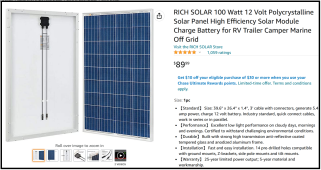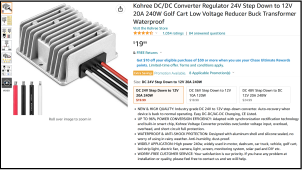LV426
New Member
- Joined
- May 24, 2022
- Messages
- 3
I could use some input before I buy some parts for a project.
I have seen a video with the basic jest of what I want to do.
Here is what I was thinking
Input: two 100 watt solar panels so that 200 watts total
to a:
Kohree DC/DC Converter Regulator 24V Step Down to 12V 20A 240W Golf Cart Low Voltage Reducer Buck Transformer Waterproof
Then to a:
FOVAL 150W Car Power Inverter 12V DC to 110V AC Converter with 3.1A Dual USB Car Charger.
I would only plan on using this if the power get knocked out from a hurricane. I'm guessing I would only need about 106 to 110 watts of the 150 watt output from the inverter to run my cooler (51 watts) and laptop (55 watts). I want to use an inverter because the panels are kind of fare away from my house to get enough sun. I would convert the DC to AC then just use a 50 foot drop cord. Plus after the laptop is charged I could use the other 50 or so watts to charge other things that can only be charged by AC like my batters I use for my lanterns. I know this is kind of inefficient but I'm trying to do something on the cheap. I already have to 200 watts of solar for charging up my Jackery. But I got my hands on a 60 watt panle that takses care of that seeing how the Jackery only charges at 39 watts.
I have seen a video with the basic jest of what I want to do.
Here is what I was thinking
Input: two 100 watt solar panels so that 200 watts total
to a:
Kohree DC/DC Converter Regulator 24V Step Down to 12V 20A 240W Golf Cart Low Voltage Reducer Buck Transformer Waterproof
Then to a:
FOVAL 150W Car Power Inverter 12V DC to 110V AC Converter with 3.1A Dual USB Car Charger.
I would only plan on using this if the power get knocked out from a hurricane. I'm guessing I would only need about 106 to 110 watts of the 150 watt output from the inverter to run my cooler (51 watts) and laptop (55 watts). I want to use an inverter because the panels are kind of fare away from my house to get enough sun. I would convert the DC to AC then just use a 50 foot drop cord. Plus after the laptop is charged I could use the other 50 or so watts to charge other things that can only be charged by AC like my batters I use for my lanterns. I know this is kind of inefficient but I'm trying to do something on the cheap. I already have to 200 watts of solar for charging up my Jackery. But I got my hands on a 60 watt panle that takses care of that seeing how the Jackery only charges at 39 watts.
Attachments
Last edited:





